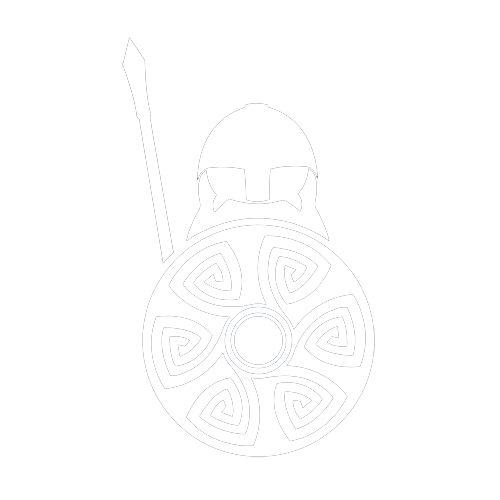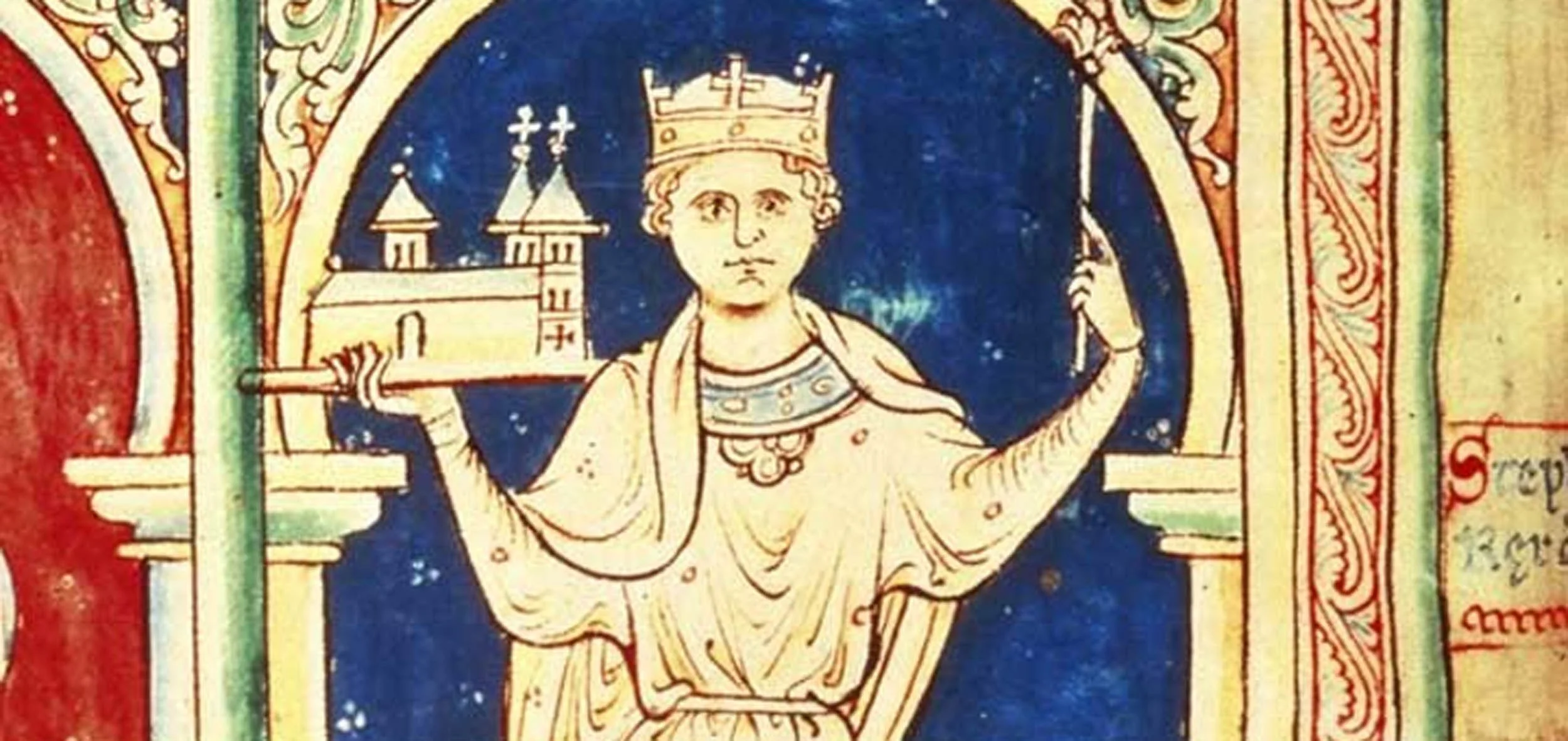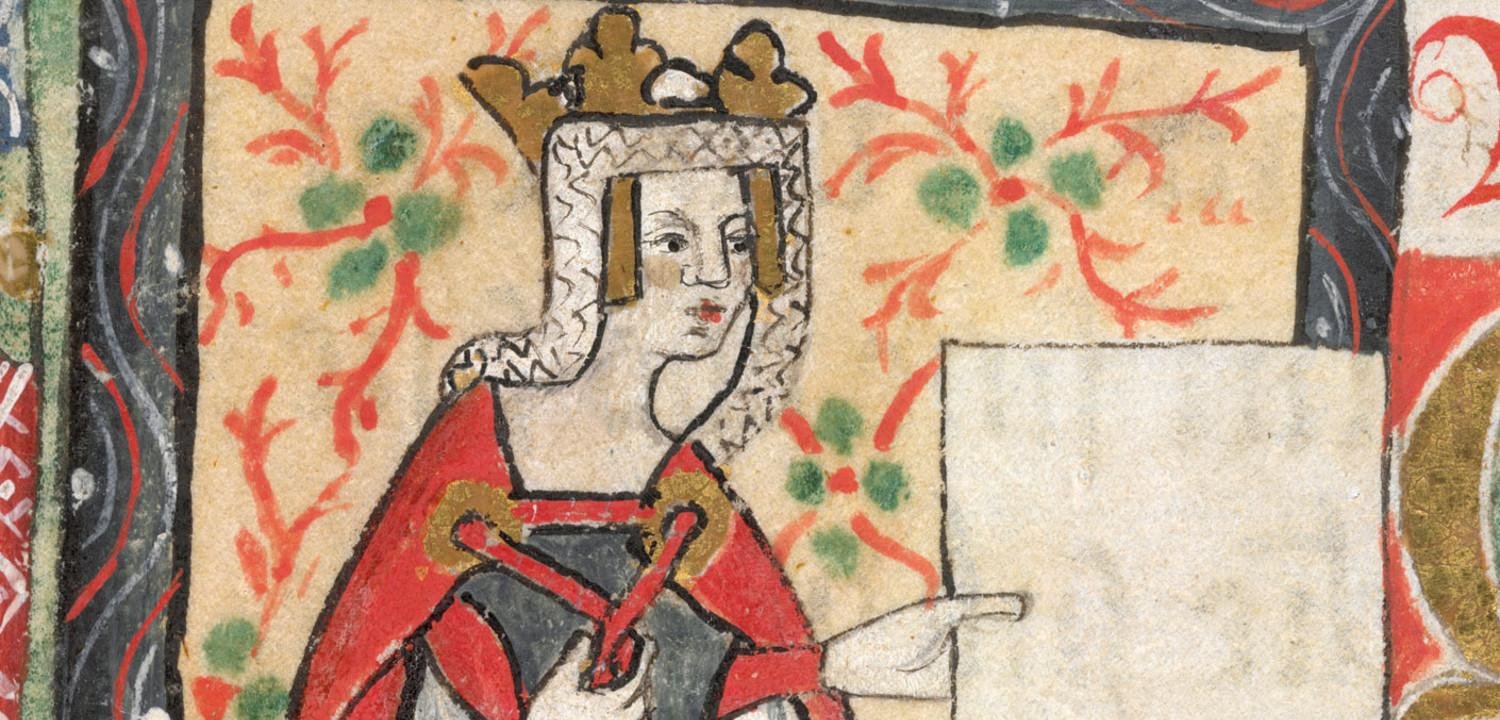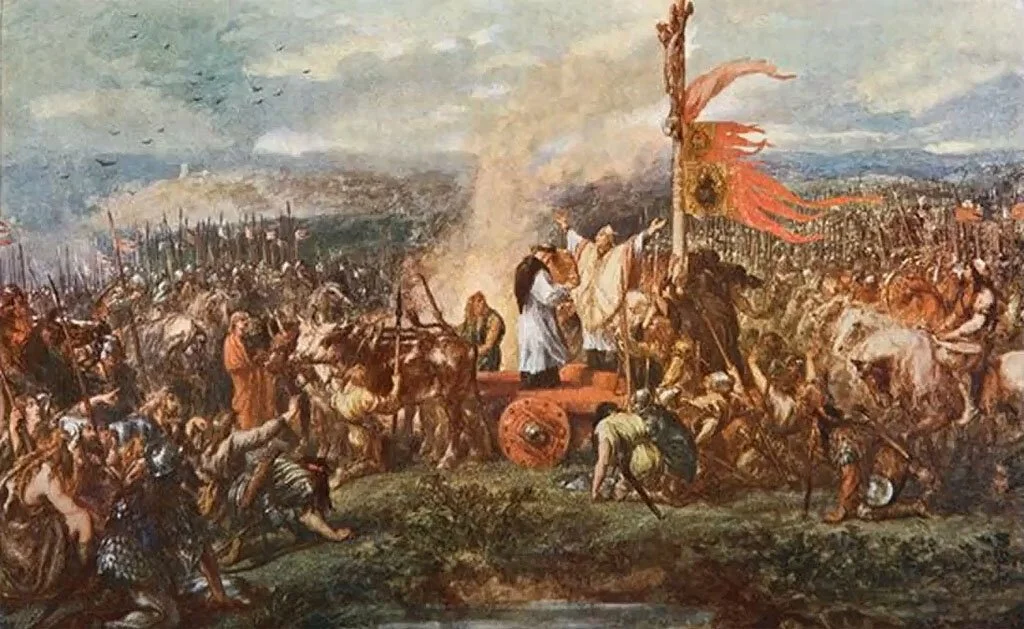King Stephen of England and Matilda
The king, Stephen of England, was not nominated as heir to the throne of England. His cousin, Matilda, who was Henry I's daughter, was instead. Matilda (or Maud as she is sometimes known) had the strongest claim, and her father rallied for an oath to be sworn by his Anglo-Norman barons, before his death, that she would become Queen of England.
However, Matilda was not a popular choice with the barons. Not only was she female, but Matilda was married into the Angevin house to Geoffrey, Count of Anjou. The Anglo-Norman barons were not in favour of an Angevin presence on the throne of England! On the other hand, Stephen of Blois, a favoured nephew of Henry I, was a very suitable candidate. With his wealth and land in Boulogne, he was able to push his claim with swift movements a few weeks after Henry's death. So now cue the bitter rivalry between the cousins, Stephen and Matilda. Ultimately leading to a civil war in England with uprisings, turmoil and loss of territory over the next 19 years.
| Born | 1097, Blois, France |
| Parents | Stephen II, Count of Blois & Adela of Normandy (daughter of William the Conqueror) |
| Married | Matilda of Boulogne |
| Children | 5, inc Eustace |
| Died | 25 October 1154, Dover, Kent (57) |
| Reign | 1135 - 1154 (break in 1141) (35) |
| Crowned | 26 December 1135, Westminster Abbey (32) and 25 December 1141, Canterbury Cathedral (44) |
| Predecessor | Henry I (uncle) |
| Successor | Matilda (cousin) and Henry II (first cousin once removed) |
| House | Blois |
Life Events of King Stephen
1097
Stephen is born in Blois, France. He is the son of Count Stephen II of Blois and Adela of Normandy, making him a grandson of William the Conqueror.
1125
Stephen marries Matilda of Boulogne, who is a great-niece of William the Conqueror. Their union strengthens Stephen's claim to the English throne.
1135
After the death of Henry I, a succession crisis emerges, with Stephen and Henry's daughter, Matilda, both claiming the throne. Stephen seizes the opportunity and has himself crowned as king, starting a period of civil war known as The Anarchy.
1135
Stephen is crowned King of England at Westminster Abbey on 22 December. His coronation marks the beginning of his reign, which faces significant challenges and conflicts.
1135
Matilda (also known as Empress Matilda or Maud), daughter of King Henry I, challenges Stephen's claim to the throne and gains support from many nobles, including her half-brother Robert, Earl of Gloucester.
1141
On 2 February, Matilda's forces, led by Robert, Earl of Gloucester, capture King Stephen during the Battle of Lincoln. Matilda's supporters proclaim her as the ruler of England.
1141
Matilda faces challenges in establishing effective rule despite her capture of Stephen. Civil war continues and the lack of widespread support undermines her position.
1141
In February, King Stephen escapes captivity, allowing him to resume his claim to the throne.
1141
Stephen is crowned again on 25 December, this time at Canterbury Cathedral.
1153
Stephen faces a stalemate with Matilda's son, Henry Plantagenet (the future King Henry II). They negotiate the Treaty of Winchester on 6 November, which recognizes Henry as Stephen's heir and secures peace in exchange for Stephen maintaining the throne for the remainder of his life.
1154
Stephen dies on 25 October 25, in Dover, England. Following his death, Henry Plantagenet succeedes him as King Henry II, bringing an end to The Anarchy.
Interesting Facts About King Stephen
Royal Lineage
Stephen was born into a prominent noble family. His mother, Adela of Normandy, was the daughter of William the Conqueror, and his father, Count Stephen II of Blois, held significant lands in France.Chance
Stephen's reign came about through a succession crisis rather than a direct claim. He took advantage of the situation following the death of his uncle, King Henry I and swiftly seized the throne.Unpopular Monarch
Stephen faced significant challenges during his reign. He struggled to gain widespread support, and many barons took advantage of the ensuing power vacuum, leading to political unrest and civil war.Capture
King Stephen experienced a major setback when he was captured during the Battle of Lincoln in 1141. He was held prisoner by Matilda's forces but was eventually released in a prisoner exchange, marking a turning point in the conflict.Inflation and Coinage
Stephen's reign saw a significant rise in inflation, partly due to the debasement of the coinage system. The quality of the coins declined, leading to economic instability and a loss of confidence in the currency.The Great Fire of 1136
London suffered a devastating fire in 1136 during Stephen's reign. The fire destroyed a significant portion of the city, including St. Paul's Cathedral, resulting in widespread destruction and economic setbacks.Castle-Building Campaign
Stephen embarked on an extensive castle-building campaign during his reign. It is estimated that he constructed over 100 new castles across England, many of which were intended to strengthen his control and serve as strategic strongholds.The Anarchy
The term ‘The Anarchy’ was coined by later historians to describe the chaotic and lawless nature of Stephen's reign. It reflects the ongoing struggles for power and the lack of stable governance during this period.Treaty of Winchester
Towards the end of Stephen's reign, negotiations led to the Treaty of Winchester in 1153. This agreement recognised Henry Plantagenet (the future King Henry II) as Stephen's heir, effectively resolving the succession crisis and paving the way for a peaceful transition of power.
Interesting Facts About Empress Matilda
Claim
Matilda's claim to the throne was based on her father's designation and the support of the English barons. She was also supported by her half-brother Robert of Gloucester, one of the most powerful nobles in England.Tough Opponent
Empress Matilda, Stephen's cousin and rival claimant to the throne, was a formidable opponent. During The Anarchy, she led military campaigns and was known as the ‘She-Captain’ due to her strong leadership and determination.Captured King
Matilda's forces captured Stephen in 1141, but she was never officially crowned as queen. However, she styled herself as ‘Lady of the English’ and ‘Empress of the English’.Escape
Matilda's most famous episode during the civil war occurred in 1141 when she successfully escaped from Oxford Castle across a frozen river, earning her the nickname ‘Empress Maud the Good Lady’.Succession
Matilda's son Henry eventually inherited the throne in 1154, becoming King Henry II. Matilda's lineage laid the foundation for the Plantagenet dynasty, which ruled England for over three centuries.Retirement
Matilda retired to Normandy after her son's accession to the throne and played an influential role in advising him on matters of governance.Death
Matilda died on 10 September 1167, in Rouen, Normandy, at the age of about 65. She was buried in the Rouen Cathedral.
Battles Fought By King Stephen
Battle of Lincoln
On 2 February 1141, this battle was a significant event during the Anarchy, a period of civil war between King Stephen and Empress Matilda. Stephen's forces, led by William of Ypres, faced the army of Matilda's supporter, Robert of Gloucester. The battle resulted in a defeat for Stephen, who was captured and taken to Bristol to be imprisoned.Battle of Wilton
On 1 July 1143, this battle occurred during the ongoing conflict between Stephen and Matilda. Stephen's forces, commanded by his brother Henry of Blois, were stationed at Wilton Abbey. A surprise attack came and the king’s forces clashed with the troops of Matilda's half-brother, Robert FitzRoy. The battle ended in Stephen’s defeat, although he escaped.Battle of Wallingford
In 1153, this battle took place during the latter stages of the Anarchy. Stephen's forces, led by his son William, confronted the army of Henry FitzEmpress (the future King Henry II) who fought in support of his mother, Empress Matilda. The battle ended in a negotiated settlement rather than a decisive military outcome, eventually leading to the Treaty of Winchester and the recognition of Henry FitzEmpress as Stephen's heir.
FAQs About the King
Who was King Stephen of England?
King Stephen, also known as Stephen of Blois, was a medieval English monarch who ruled as the King of England from 1135 to 1154. He reigned during a period known as ‘The Anarchy’, a civil war that erupted after the death of his predecessor, King Henry I.How did King Stephen come to the throne?
After the death of King Henry I, Stephen seized the throne in 1135, despite the prior designation of Henry's daughter, Empress Matilda, as his heir. Stephen's claim was supported by a faction of English barons who preferred him over Matilda. This led to a prolonged conflict between Stephen and Matilda, known as the Anarchy.Did King Stephen achieve any notable accomplishments as king?
Stephen faced numerous challenges during his reign, but he did manage to secure some notable achievements. He maintained control over parts of England throughout the conflict and successfully defended his position against Matilda's forces. Stephen also negotiated a peace agreement called the Treaty of Winchester in 1153, which paved the way for his eventual successor, Henry II, to ascend to the throne.How did King Stephen's reign end?
In 1153, a negotiated settlement known as the Treaty of Winchester was reached between Stephen and Matilda's son, Henry. As part of the agreement, Stephen recognized Henry as his heir, effectively ending the civil war. Stephen died the following year in 1154, and Henry II succeeded him as king.What was King Stephen's legacy?
Stephen's reign left a lasting impact on England. The Anarchy brought significant suffering to the country, with widespread devastation and social upheaval. It also set a precedent for the importance of a clear line of succession and helped shape the future development of English law and governance under Henry II.
Further Reading
Stephen of Blois was the son of Stephen, Count of Blois and Adela (William the Conqueror's daughter). After Stephen's father was killed on a crusade in 1102 in Israel, Stephen was placed into the royal court of his uncle, Henry I. There he gained wealth, land and power by marrying Matilda of Boulogne in 1125. This marriage enabled him to control a major trade route between England and France.
Stephen of Blois was very well liked amongst most of Henry I's barons, and was very intelligent. However, Stephen was not a ruthless warrior like his Norman predecessors, and this would cause problems later on in his reign.
Empress Matilda
Matilda was the daughter of Henry I, and granddaughter of William the Conqueror. She was also the cousin of Stephen of Blois. Matilda, sometimes known as Maud, moved to Germany as a child and married Henry V, King of Germany and the Holy Roman Emperor. In 1125, Henry V died, and Henry I of England summoned Matilda back to Normandy upon news of the death of her brother, William Adelin, on the White Ship. This tragedy would leave Henry without a male heir.
In a bid to protect his borders, Henry arranged the marriage of Matilda to Geoffrey of Anjou. Henry nominated Matilda as his heir, as no other heirs were available. He insisted that his barons swear an oath of loyalty to Matilda, upon his death. This would seal his succession, in his mind, with House the Angevin. However, after Henry's death, Matilda and Geoffrey faced opposition to their claim from all but a few loyal barons. Stephen was seen as the favoured successor.
King Stephen of England
A few weeks after Henry I's death, Stephen swiftly travelled to England from France. He made his claim to be King Stephen of England, and was backed by some loyal barons. Matilda was not in England at the time. Stephen was crowned King of England at Westminster Abbey on 26 December 1135. But it wasn't long before Stephen's reign would come under attack.
The Battle of Standard
David I of Scotland, who spent his teenage years at the royal court of Henry I, supported his niece Matilda's claim. David decided to invade northern England, to not only support Matilda but to also increase his territory. He received support from Eustace de Vescy, who handed over his fortress, Alnwick Castle to support the effort. Stephen sent a smaller army of armoured mercenaries up to meet David, with the Archbishop of York gathering most of the troops under the pretence they were doing God's work. The combination of consecrated banners from York Minster, John of Beverley and Wilfrid of Ripon (with symbols of the patron saints of each city) were combined on a mast at the centre of the English line. This formed the standard, and the name of the battle.
David's army attacked in 1138, confidant with a larger army. But England's troops were heavily armoured and the wild Scots fell quickly. David had no choice but to retreat, and the English did not pursue. Stephen later met David at Durham, and signed a truce, giving Carlisle to David and giving David's son, Prince Henry, the Earldom of Huntingdon. A soft approach from Stephen that angered his barons.
The Anarchy Civil War in England
The Anarchy was the name of the civil war in England between 1135 and 1154. The exact time that Stephen was king of England. During the civil war, Stephen had to deal with various uprisings. Some coming from from the Welsh and most notably lots coming from his disloyal barons and his cousin Matilda.
Welsh Rebellions
In 1136, the Welsh saw an opportunity to recover the lands lost to the Marcher Lords, who were trusted nobles appointed by the king to guard his borders. The Welsh Marches had the most castles built along the border, in an attempt, by William the Conqueror, to control the Welsh. It was this opportunity, when the Welsh saw how weak Stephen was, that sparked the Battle of Llwchwr (Gower). The Norman army under Stephen had underestimated the strength of the Welsh rebellion, and lost 500 men in the battle.
This Welsh victory spurred on other Welsh rebellions, in the Great Revolt, including a battle near Kidwelly castle, and the Battle of Crug Mawr (Great Barrow). South Wales was rising up to the Norman powers, but would be largely left to their own devices by Stephen, who had other considerable concerns from Matilda.
Disloyal Barons and Imprisoned Bishops
Robert Fitzroy, Earl of Gloucester
King Stephen had lost a few barons to Matilda's cause, the most notable being the powerful Robert Fitzroy, Earl of Gloucester. Robert was an illegitimate son of Henry I and Matilda's half brother, who had deep loyalties to Matilda's cause. Robert would be at the forefront of the battle of Lincoln.
Henry of Blois
Henry of Blois, Bishop of Winchester and the brother of king Stephen, had initially supported Stephen during the push for the throne. He desired to be Archbishop of Canterbury, but obligated his time to Glastonbury Abbey instead. After the Battle of Lincoln, Henry decided it would serve him better to switch allegiance to Matilda's cause. However, he found Matilda arrogant and decided to switch back to his brother Stephen. Later on, Henry's help in the successful defence of the Rout of Winchester, would lead to the turning point in the civil war.
Ranulf de Gernon, Earl of Chester
Ranulf, Earl of Chester had inherited lands in the north from his father. During the truce at Durham, after the Battle of the Standard, king Stephen gave away Ranulf's lands to David I of Scotland. This enraged Ranulf, who left Stephen's court immediately. His allegiances switched to Matilda's, and Ranulf would later take Lincoln Castle.
Imprisoned Bishops
King Stephen was losing control of his realm. He had 3 bishops, including Roger of Salisbury, arrested for assumed treason in 1139. He was concerned with the growing power the bishops had, with the number of castles they were building, and the increasingly large armed forces they were producing. Stephen feared that they would plot against him. By imprisoning the bishops, and demanded the castles' surrender, Stephen had damaged his relationship with this bishop brother, Henry of Blois.
The Battle of Lincoln
The Battle of Lincoln, in 1141, was the culmination of the above events. After Ranulf had taken Lincoln castle, Stephen had decided to negotiate with him. The result was that Ranulf would leave Lincoln castle with powers given to him over the town of Derby and it's castle. Ranulf accepted this offer and left Lincoln. But Stephen would later hear word of mistreatment from the people of Derby, and so the king marched upon Lincoln and besieged the castle.
Ranulf escaped, but his wife Maud (daughter of Robert, Earl of Gloucester) was trapped inside. Ranulf requested the aid of Maud's father Robert, and with that Robert raised an army and together with Ranulf, marched on Lincoln. Joining them were a large group of Welsh troops. King Stephen's advisers suggested the king leave, but Stephen chose to stay, despite the odds.
The king lost most of his leading Earls, as they fled at the site of the advancing armies, led by Robert. Determined to face Robert, Stephen and his remaining nobles attacked. However, no matter how bravely they fought, the Angevins killed most of the royal army, then surrounded the king, captured him and took him to Bristol as their prisoner.
Lands in Normandy
News of Stephen's capture reached Geoffrey of Anjou. This prompted him to invade Normandy again, and take the Duchy south of the river Seine and east of the river Risle.
Matilda's Reign and her Son, Henry's Rise
With Stephen now imprisoned in Bristol, Matilda could move to London and take control of the throne of England. Just as she and her loyal followers had worked so hard for. However, Matilda was arrogant, greedy and after a while she fell out of favour with the London population.
Eventually her support waned, and Matilda of Boulogne (Stephen's queen) rallied London into a revolt against Matilda, forcing her out before ever being crowned. Shortly after, Robert Earl of Gloucester, the loyal supporter of Matilda was captured. Matilda was then forced to trade prisoners, King Stephen for Robert, which she did.
King Stephen was once again back on the throne of England, and re-crowned on Christmas Day in 1141 at Canterbury Cathedral. Stephen's reign would continue to be blighted by civil war until his death in 1154. Barons took advantage of the turmoil and built many unauthorised castles across the land, forcing misery onto the general population.
By 1147, when Robert Earl of Gloucester died, Matilda gave up her pursuit of the crown, and returned to her husband in Normandy. There she would concentrate her ambitious plans on her son, Henry FitzEmpress. Henry would later invade England in 1147, with a small, poorly paid army. The invasion would fail, and for some unknown reason, King Stephen paid the costs for their safe return to Normandy! Perhaps to continue the relative peace that was present.
King Stephen's generosity would not be appreciated long, and Henry FitzEmpress invaded again in 1149, forming an alliance with Ranulf of Chester and David I of Scotland. The plan involved Ranulf giving up his claim to Carlisle (owned by the Scots) in return for rights to Lancaster. This would form a peace agreement between Ranulf and David, and with Henry at the helm, they could attack York together. Stephen marched north to intercept the invasion, and Henry swiftly returned to Normandy.
King Stephen's succession
King Stephen's eldest son, Eustace, was the obvious heir. Stephen tried to get Eustace crowned while he was still alive, as they did in France, but this was banned in England. Despite desperate attempts to have Eustace crowned, even imprisoning bishop Theobald for refusing to carry out the coronation, Eustace was never crowned.
Henry FitzEmpress returned to England again in 1153, with a small army. This time, Stephen could not control Henry's invasion and negotiated a temporary truce. This left Henry free to control the north, midlands and south-west of England.
Wallingford Castle was still a stronghold for Angevin supporters, and Stephen's army tried again to besiege it. When the first signs appeared that the castle may fall, Henry arrived with a relief army and besieged Stephen's forces from behind. When Stephen arrived with his own army to help, Henry was waiting for him across the River Thames. This time the church negotiated a truce at the banks of the river. Stephen and Henry had a private discussion about ending the war.
Furious by this truce, Eustace returned to Cambridge to gather support for a fresh campaign, but he died from illness shortly after arrival in 1153. It is said that the cause of Eustace's anger was actually from the fact that his succession was not discussed during the private conversation between Stephen and Henry. Perhaps pointing to a long-term peace with Henry at the throne.
At Winchester Cathedral, the Treaty of Winchester was announced, which stated that Stephen recognised Henry FitzEmpress as his adopted son and successor. In return, Henry would pay homage to Stephen, William (Stephen's other son) would pay homage to Henry and renounce his claim to the throne. All foreign armies would leave, and all Henry's castles would be accessible to Stephen.
The King Stephen of England died on 25 October 1154, and Henry FitzEmpress succeeded the throne as Henry II of England. A new French House had become successor to the English throne.





